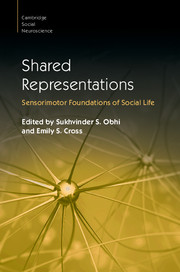Book contents
- Shared Representations
- Cambridge Social Neuroscience
- Shared Representations
- Copyright page
- Contents
- Figures
- Tables
- Boxes
- Contributors
- Preface
- Part I Foundations
- Part II Imitation and Mimicry
- Part III Thinking, Perceiving and Acting with Others
- Part IV Understanding Others
- Part V Learning and Development
- Part VI Shared Representations in Applied Contexts
- 27 Sport Performance
- 28 Shared Mental Models in Sport and Refereeing
- 29 Musical Synchronization, Social Interaction and the Brain
- 30 You Move, I Watch, It Matters
- Index
- Plate Section (PDF Only)
- References
30 - You Move, I Watch, It Matters
Aesthetic Communication in Dance
from Part VI - Shared Representations in Applied Contexts
Published online by Cambridge University Press: 27 October 2016
- Shared Representations
- Cambridge Social Neuroscience
- Shared Representations
- Copyright page
- Contents
- Figures
- Tables
- Boxes
- Contributors
- Preface
- Part I Foundations
- Part II Imitation and Mimicry
- Part III Thinking, Perceiving and Acting with Others
- Part IV Understanding Others
- Part V Learning and Development
- Part VI Shared Representations in Applied Contexts
- 27 Sport Performance
- 28 Shared Mental Models in Sport and Refereeing
- 29 Musical Synchronization, Social Interaction and the Brain
- 30 You Move, I Watch, It Matters
- Index
- Plate Section (PDF Only)
- References
Summary
In this chapter we will introduce a new theory of aesthetics in the performing arts that is based on communication via movement. With a specific focus on dance performances, we propose that movement messages are communicated from performer to spectator. We suggest that the aesthetic impact of dance (and perhaps all performing arts) is a result of successful message-passing between performer and spectator. We show how Grice’s four maxims of successful conversation can be applied to the performance situation. We propose that communication during a performance is interactive and bidirectional. Information being passed from performer to audience is primarily communicated through observed movement kinematics and choreographic structure: we will distinguish between the processing of syntactic information of postures, movements and movement sequences, on the one hand, and processing of semantics of movement intentions, on the other hand. Aesthetic processing of the movement message will further depend on the spectator’s visual and motor expertise. In a dimensional model of aesthetic appreciation of dance, we distinguish between processing fluency and novelty/complexity of information as two distinct sources of movement aesthetics that relate to specific brain mechanisms. Aesthetic judgements of preference and interest will reflect a combination of both implicit processing fluency and the explicit aesthetic strategy of the observer. Our theory differs from existing accounts of aesthetic experience in that it emphasises successful communication as the primary source of aesthetic experience. Appreciation of dance in this context is neither just a function of dance movement features (as an objectivist aesthetics suggests) nor of the spectator’s processing fluency (as a subjectivist aesthetics suggests). Instead, our emphasis on communication implies some level of experience-sharing between dancer and spectator.
- Type
- Chapter
- Information
- Shared RepresentationsSensorimotor Foundations of Social Life, pp. 627 - 653Publisher: Cambridge University PressPrint publication year: 2016
References
- 13
- Cited by



